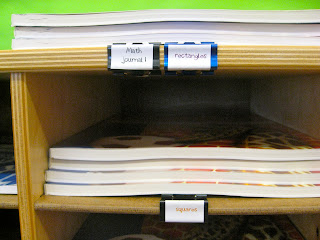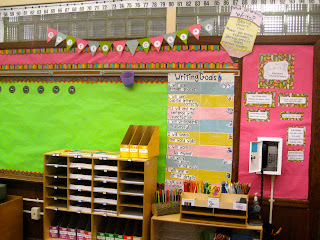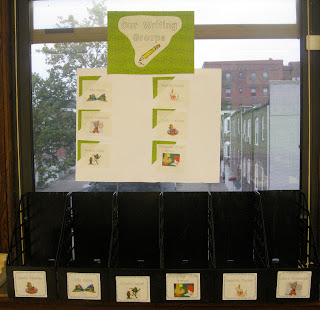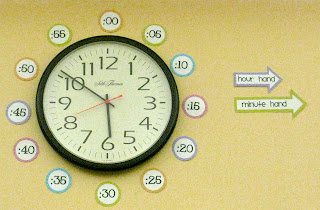One useful strategy for me is sticky labels. It took me a few years to learn how to make my own mailing labels in Microsoft Word. I should say, it took me a few years before I stopped calling my mom and making her print them for me and mail them from Buffalo before I finally asked someone to teach me!! Once I asked for help, it took about 65 seconds to learn. Seriously? It's that easy? Before the school year starts, I print several copies of mailing labels with the student names. As soon as a supply or new book comes in, I peel off a label and stick it on. No time is wasted looking for a sharpie and writing on everything! When sweaters come off, new lunch boxes are purchased, or book orders come in, I can simply peel the student's name off the sheet of labels and am ready in an instant. Best of all, if we have a staff developer or sub in the classroom, these can double as quick name tags.
I also have labels for every academic material I am expecting in my classroom, such as the various folders, notebooks, and portfolios. These are all color coded and then have identical labels telling parents and any classroom visitors what they are used for. The bins they belong in throughout my classroom have a large version of that same label so it's obvious where to return things.
That brings me to my second strategy- color coding. If your school didn't implement this already, it's not an easy thing to start midyear, but I do recommend it or next year! My supply list on the first day of school asked for folders in specific colors. I then used my labels to organize student folders by color. Everything belongs in a bin of the same color. For example, writing folders are green, poetry folders are red, homework folder are purple, and math folders are blue. I then color code the labels for everything to coordinate with the color I associate with that content area. When it's time to pack up, I don't have to worry about students bringing home the wrong folders, I tell them "pack up your purple homework folders," and can see from where I'm standing if the folder they have out is purple. This is BIG this year, since I keep catching students bringing home the most surprising classroom materials (and never returning them).
Here is a photo tour of some of the scaffolds I've put in place to help my teacher-dependent group.
As soon as students arrive, they are reminded of the morning routines. Since my room has loud metal lockers that the students can easily pinch their fingers in, it is important to me that they do not need to return to their backpacks before the end of the day. The classroom door reminds them exactly where to put anything they bring to school in the morning. Sorry it's so difficult to read the steps, my camera isn't the greatest!
 |
| Illustrated morning routines |
My Bravo Board: Table Points are nothing new for any teacher, but I have had to become a lot more consistent and spend a major portion of the day adding points. While before it was used for behavior, it's now used to award any table that finishes a task efficiently. "Wow! Everyone at your table actually took off their coats today? You get a point!" Every Friday the table with the most points gets to visit the treasure chest. This is a great classroom management tool because the students hold one another accountable for their behavior, and no one wants to disappoint their friends!
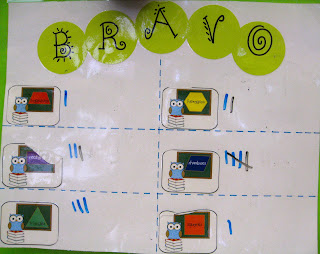 |
| This board tracks table points. |
As you've seen in previous posts, my classroom has tables, which means no personal storage for the students. Teachers have strong opinions on desks vs. tables, and I actually love the tables. When I taught in the upper grades, I received a grant through Donor's Choose which allowed me to replace my desks with tables, and it was heaven! Nevertheless, my students were wasting too much time digging through each section of the caddy looking for what they needed. The caddies were a mess, and the number of personal items they began to store in the caddies became out of control. I created illustrated labels that reminds the students where each writing tool belongs. Table leaders are encouraged to organize the supplies at the beginning and end of each day. When I do spot checks, tables with organized caddies get a point! Here's a bonus- in first grade they still haven't caught on to the fact that if EVERYONE get's a point, no one is any further ahead. The class is most excited when all of the tables are winning. I love it!
You can download my caddy labels from my Teachers Pay Teachers store for free by clicking on the photo above.
 |
| Class jobs & book changing chart |
 | |
| Book Shopping Procedure |
 |
| Fountas and Pinnell Guided Reading Levels "We're Mooo-ving Up Reading Levels!" |
I strongly disagree with telling a student he is not allowed to use the bathroom during a certain part of the day. When you have to go, you have to go! However, I began to notice students asking to go to the bathroom multiple times a day, and then "forgetting" to use the bathroom! It's a great way to get out of the room and check out what your friends are doing in other classes. For that reason, I have implemented a Bathroom Procedure board. This board is magnetic. When students use the bathroom, they slide their name to the right side of the board. So far no one has asked to go after they have already moved to the right side, and the number of unnecessary interruptions for bathroom breaks has been minimized.
 |
| Bathroom Chart |
During writing I provide my ELL students with personal word walls/ word banks. I would LOVE to share these with you, but a lot of the images I use are from Google images, and many of them are for personal use only. These word walls are each about a page long and have labeled pictures of the most commonly used words for a specific topic. For example, if a student is writing about a trip to the doctor, she would receive a personal word wally with pictures of common things you see in a doctor's office and the names. Once a student receives a word wall, he can keep it for the rest of the year. I don't pass out all of the word walls at once, as this can become overwhelming and confusing. It's also important that they don't rely too heavily on the word walls and forget how to sound things out.
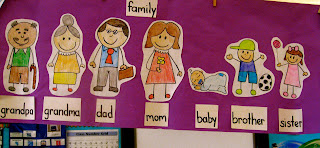 |
| Family Words |
Each student created an idea list similar to the chart below on the first day of our personal narratives "small moments" writing unit. This chart will stay up for the entire unit so students can quickly and independently start new stories.
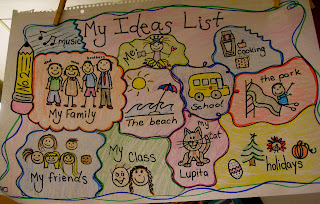 |
| My Ideas List |
This final chart isn't the most visually appealing, but I wanted to keep it very basic to remind students of what we do during Writer's Workshop. It's an attempt to avoid hearing "I'M DONE!"
Finally, this is a quick look at how I display strategies we have learned this month in reading and writing. During the lesson the strategy of the day is displayed on the Smartboard. Following this, the strategy is printed and added to the doors below.
Thanks for continuing to follow my year! I am so lucky to have a group of really sweet and loving students this year. I hope as I continue to implement more rigid routines they can also become more independent and build stamina.

 Supply Caddy Labels
Supply Caddy Labels




